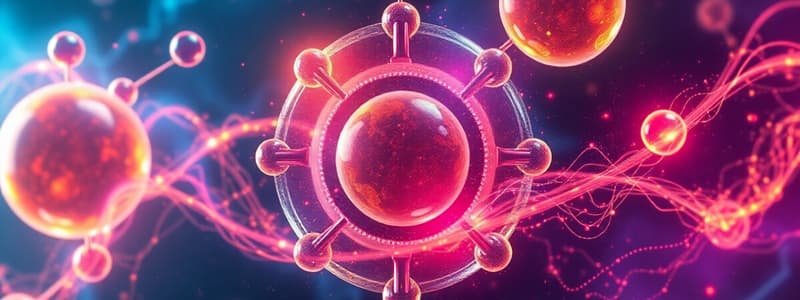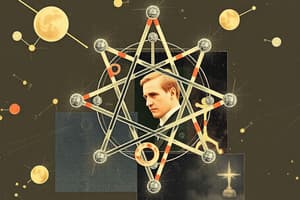Podcast
Questions and Answers
Which characteristic is NOT associated with bases?
Which characteristic is NOT associated with bases?
- Releases hydrogen ions in solution (correct)
- Turns red litmus blue
- Slippery feel
- Bitter taste
What is the molar mass of a substance measured in?
What is the molar mass of a substance measured in?
- g/ml
- g/Watt
- g/mol (correct)
- kg/L
Which statement regarding reaction rates is incorrect?
Which statement regarding reaction rates is incorrect?
- Temperature influences reaction rates.
- Catalysts increase the rate of chemical reactions.
- Higher concentration typically reduces reaction rates. (correct)
- Surface area can affect how quickly a reaction occurs.
What describes an endothermic reaction?
What describes an endothermic reaction?
Which of the following is a key component of a Chemical Hygiene Plan?
Which of the following is a key component of a Chemical Hygiene Plan?
Which statement accurately describes the characteristics of metals?
Which statement accurately describes the characteristics of metals?
What distinguishes a compound from a mixture?
What distinguishes a compound from a mixture?
Which of the following reactions is categorized as a combustion reaction?
Which of the following reactions is categorized as a combustion reaction?
What is the atomic number of an element indicative of?
What is the atomic number of an element indicative of?
Which type of bond is formed through the sharing of electrons?
Which type of bond is formed through the sharing of electrons?
In which state of matter do particles have the most freedom to move?
In which state of matter do particles have the most freedom to move?
Which of the following is a characteristic property of acids?
Which of the following is a characteristic property of acids?
Which of the following describes a double replacement reaction?
Which of the following describes a double replacement reaction?
Flashcards are hidden until you start studying
Study Notes
Basic Concepts in Chemistry
- Matter: Anything that has mass and occupies space.
- Elements: Pure substances that cannot be broken down (e.g., hydrogen, oxygen).
- Compounds: Substances formed from two or more elements chemically bonded (e.g., water, H₂O).
- Mixtures: Combinations of two or more substances that retain their individual properties (e.g., saltwater).
Atomic Structure
- Atom: The smallest unit of an element, consisting of:
- Protons: Positively charged particles in the nucleus.
- Neutrons: Neutral particles in the nucleus.
- Electrons: Negatively charged particles orbiting the nucleus.
- Atomic number: Number of protons in the nucleus; defines the element.
- Mass number: Total number of protons and neutrons.
Chemical Bonds
- Ionic Bonds: Formed when electrons are transferred from one atom to another, resulting in charged ions.
- Covalent Bonds: Formed when atoms share electrons to achieve stability.
- Metallic Bonds: Bonds found in metals where electrons are shared and can move freely.
States of Matter
- Solid: Definite shape and volume; particles are closely packed.
- Liquid: Definite volume but take the shape of their container; particles are less tightly packed.
- Gas: No definite shape or volume; particles are far apart and move freely.
Chemical Reactions
- Reactants: Substances that undergo a change during a reaction.
- Products: Substances formed as a result of a chemical reaction.
- Types of Reactions:
- Synthesis: Two or more substances combine to form a new compound.
- Decomposition: A single compound breaks down into two or more simpler substances.
- Single Replacement: One element replaces another in a compound.
- Double Replacement: Exchange of ions between two compounds.
- Combustion: Reaction with oxygen producing energy, typically involves hydrocarbons.
The Periodic Table
- Groups: Vertical columns; elements share similar properties (e.g., Group 1: Alkali metals).
- Periods: Horizontal rows; represent energy levels of electrons.
- Metals, Nonmetals, and Metalloids: Classification based on properties.
- Metals: Good conductors, malleable, ductile.
- Nonmetals: Poor conductors, brittle, can exist in all states.
- Metalloids: Properties of both metals and nonmetals.
Acids and Bases
- Acids: Substances that release hydrogen ions (H⁺) in solution (e.g., HCl).
- Characteristics: Sour taste, turn blue litmus red.
- Bases: Substances that release hydroxide ions (OH⁻) in solution (e.g., NaOH).
- Characteristics: Bitter taste, slippery feel, turn red litmus blue.
- pH Scale: Measures acidity (0-7) to neutrality (7) to alkalinity (7-14).
Stoichiometry
- Mole: A unit representing 6.022 x 10²³ particles (atoms, molecules).
- Molar Mass: Mass of one mole of a substance, measured in g/mol.
- Balanced Equations: Equations must have the same number of atoms of each element on both sides.
Thermochemistry
- Endothermic Reaction: Absorbs heat from surroundings.
- Exothermic Reaction: Releases heat to surroundings.
- Enthalpy (ΔH): Heat content of a system; changes during reactions.
Kinetics and Equilibrium
- Reaction Rate: Speed at which reactants turn into products; affected by temperature, concentration, surface area, and catalysts.
- Chemical Equilibrium: The state where the forward and reverse reactions occur at the same rate; concentrations of reactants and products remain constant.
Organic Chemistry
- Hydrocarbons: Compounds made solely of carbon and hydrogen.
- Functional Groups: Specific groups of atoms that confer properties and reactivity (e.g., hydroxyl -OH, carboxyl -COOH).
- Isomers: Compounds with the same molecular formula but different structures.
Safety in Chemistry
- Personal Protective Equipment (PPE): Includes goggles, gloves, and lab coats.
- Chemical Hygiene Plan: Protocols to ensure safe handling of chemicals in laboratory settings.
Basic Concepts in Chemistry
- Matter is anything that has mass and occupies space.
- Elements are pure substances that cannot be broken down further, examples include hydrogen and oxygen.
- Compounds are substances formed by the chemical bonding of two or more elements. Water (H₂O) is a common example.
- Mixtures are combinations of two or more substances where each substance retains its individual properties. Saltwater is an example.
Atomic Structure
- The atom is the smallest unit of an element.
- Atoms consist of three subatomic particles:
- Protons are positively charged particles located in the nucleus of the atom.
- Neutrons are neutral particles also located in the nucleus.
- Electrons are negatively charged particles orbiting the nucleus.
- The Atomic number is the number of protons in an atom's nucleus and defines the element.
- The Mass number of an atom is the sum of protons and neutrons.
Chemical Bonds
- Ionic bonds form when one atom transfers electrons to another, resulting in the formation of oppositely charged ions.
- Covalent bonds occur when two atoms share electrons to achieve stability.
- Metallic bonds are found in metals. In this type of bond, electrons are delocalized and can move freely throughout the metal.
States of Matter
- Solids have a definite shape and volume. Their particles are closely packed.
- Liquids have a definite volume but take the shape of their container. Their particles are less tightly packed.
- Gases have no definite shape or volume. Their particles are far apart and move freely.
Chemical Reactions
- Reactants are substances that undergo changes during a reaction.
- Products are substances formed during a reaction.
- Types of reactions:
- Synthesis: Two or more substances combine to form a new compound.
- Decomposition: A single compound breaks down into two or more simpler substances.
- Single replacement: One element replaces another in a compound.
- Double replacement: There is an exchange of ions between two compounds.
- Combustion: A substance reacts with oxygen to produce energy.
The Periodic Table
- Groups are vertical columns in the periodic table. Elements in the same group share similar properties.
- For example, Group 1 elements are known as alkali metals.
- Periods are horizontal rows in the periodic table. Period numbers represent the principal energy level in an atom.
- Metals, nonmetals, and metalloids represent groupings based on properties:
- Metals are good conductors of heat and electricity, malleable and ductile.
- Nonmetals are poor conductors, brittle, and can exist in all states.
- Metalloids exhibit properties of both metals and nonmetals.
Acids and Bases
- Acids are substances that release hydrogen ions (H⁺) in solution. A common example is hydrochloric acid (HCl). Acids have several characteristics:
- They taste sour.
- They turn blue litmus paper red.
- Bases are substances that release hydroxide ions (OH⁻) in solution. For instance, sodium hydroxide (NaOH). Bases have these characteristics:
- They taste bitter.
- They have a slippery feel.
- They turn red litmus paper blue.
- The pH scale measures acidity (0-7), neutrality (7), and alkalinity (7-14).
Stoichiometry
- The mole is a unit representing 6.022 x 10²³ particles (atoms, molecules, etc.).
- Molar mass is the mass of one mole of a substance, measured in g/mol.
- Balanced equations must have the same number of atoms of each element on both sides of the equation.
Thermochemistry
- Endothermic reactions absorb heat from the surroundings.
- Exothermic reactions release heat to the surroundings.
- Enthalpy (ΔH) is the heat content of a system. It changes during chemical reactions.
Kinetics and Equilibrium
- Reaction rate is the speed at which reactants are converted into products. Factors that influence reaction rate include:
- Temperature
- Concentration
- Surface area
- Use of catalysts
- Chemical equilibrium is the state where the forward and reverse reactions occur at the same rate. At equilibrium, the concentrations of reactants and products remain constant.
Organic Chemistry
- Hydrocarbons are compounds that contain only carbon and hydrogen atoms.
- Functional groups are specific groups of atoms within a molecule that confer unique properties and reactivity. Examples:
- Hydroxyl group (-OH)
- Carboxyl group (-COOH)
- Isomers are compounds with the same molecular formula but different structural arrangements.
Safety in Chemistry
- Personal Protective Equipment (PPE) is crucial for safety in the laboratory. This equipment includes:
- Goggles
- Gloves
- Lab coats
- Chemical Hygiene Plan outlines protocols and measures for the safe handling and storage of chemicals in a laboratory setting.
Studying That Suits You
Use AI to generate personalized quizzes and flashcards to suit your learning preferences.




